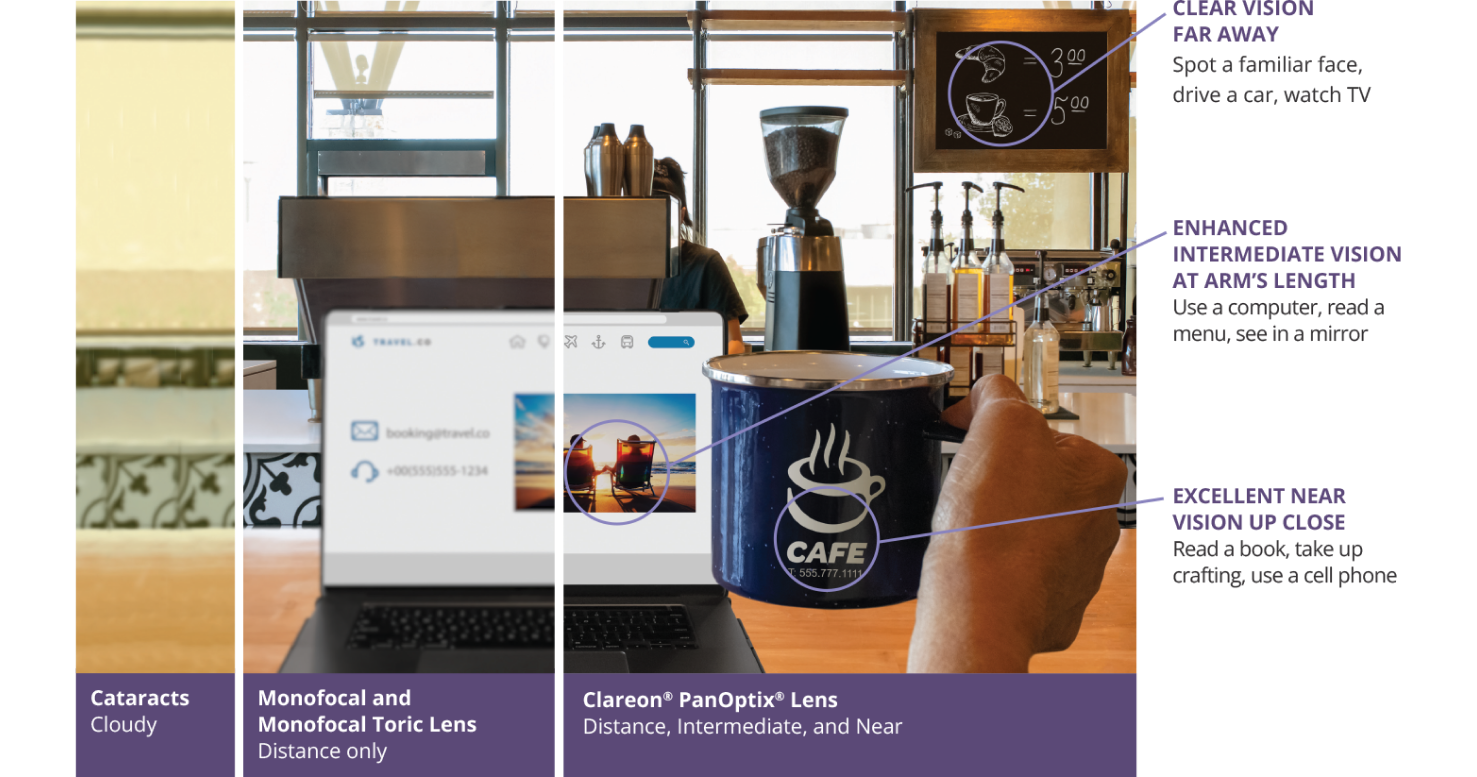|
|
SEE THINGS
DIFFERENTLY
EVERYWHERE YOU LOOK
Enjoy a Full Range of Vision and Exceptional Clarity Without Glasses1,2
When you invest in your vision, you’re investing in your future. The Clareon® PanOptix® Intraocular Lens (IOL) is your opportunity to gain vision that’s crisp and sharp.
Take advantage of the first trifocal lens available in the United States.

20/20 Near, Intermediate, and Distance Vision is Now Possible1
Clareon® PanOptix® is an advanced type of trifocal lens that uses ENLIGHTEN® technology, to help optimize vision at intermediate and distance, while still maintaining exceptional vision for both near and far distances.1

Benefits of Clareon® PanOptix® Lens
When you can see more, you can do more. Redefine your vision with the Clareon® PanOptix® Lens, and start seeing life differently.
|
|
Enhance your vision for clear, complete focus1,2 |
|
|
Discover bright, vivid colors3 |
|
|
See effortlessly, from near to far1 |
|
|
Reduce your need to wear glasses1,4 |
Patients Love PanOptix®
In a clinical study, 129 patients were asked about their experience with the PanOptix® Lens.


Of patients with the Clareon® PanOptix® Lens would choose the same lens again.1


Of patients with the Clareon® PanOptix® Lens would recommend it to family and friends.1
Know Your Options,
Put Your Future in Focus
The Clareon® PanOptix® Lens gives you a full range of vision, so that you can immerse yourself in a full range of activities—all while relying less on glasses.1,4 Here’s a visual example to help you understand the kind of vision improvements that come with a trifocal lens.

Frequently Asked Questions About Trifocal Intraocular Lenses
Get the information you need to guide you to an informed decision about the cataract replacement lens that best fits your budget and your lifestyle.
WHAT IS A TRIFOCAL INTRAOCULAR LENS?
A trifocal lens is a type of intraocular lens that is used to replace the natural lens of the eye during cataract surgery. Like a trifocal eyeglass lens, a trifocal lens contains three different prescriptions in one lens, allowing the patient to see clearly at far, intermediate, and near distances reducing, or sometimes eliminating, the need for glasses or contacts.1,4
Trifocal lenses are a relatively new technology and considered an advanced lens type. They are typically more expensive than other types of intraocular lenses. As with any medical procedure, it is important to consult with an ophthalmologist to determine whether a trifocal lens is the right choice for your specific needs.
IS THE CLAREON® PANOPTIX® INTRAOCULAR LENS RIGHT FOR ME?
You have options when it comes to cataract surgery. Choosing the right lens for your needs is a personal decision that should be discussed with your eye surgeon. Generally, trifocal lens are a good option for people who:
• Want to reduce their dependence on glasses: Trifocal lenses are designed to provide good vision at far, intermediate, and near distances, which can reduce the need for glasses or contacts, or even eliminate it altogether.1,4
• Have realistic expectations: While trifocal lenses can improve vision at multiple distances, they may not completely eliminate the need for glasses or contacts, and some patients may experience visual side effects such as halos or glare.
• Are willing to pay some of the cost out-of-pocket: Trifocal intraocular lenses are typically more expensive than other types of lenses, which may be a consideration for some patients.
IS A TRIFOCAL INTRAOCULAR LENS COVERED BY INSURANCE?
Trifocal lenses are more expensive than monofocals and, typically, an insurance company will not cover elective parts of cataract surgery, including different types of lenses and laser-assisted cataract surgery.5 This means that, if you want a trifocal intraocular lens, you will pay out-of-pocket costs for at least part of the procedure. But if the possibility of reducing the dependence on glasses or being able to see clearly at all distances without glasses1,4 is important to you, the benefits may outweigh the cost. Learn more about the cost of cataract surgery and insurance coverage.
When you invest in your vision, you deserve to know the difference between cataract replacement lens options.
You have a choice when it comes to the right type of lens for you.
Lead the Conversation
You have options when it comes to your intraocular lenses. Lead the conversation with your doctor to understand the cataract lens choice that’s right for you.
Find a cataract surgeon near you
Use our Cataract Surgeon Finder tool to locate a surgeon near you who offers a range of IOL options

IMPORTANT PRODUCT INFORMATION - CLAREON® FAMILY OF IOLS
CAUTION: Restricted by law to sale by or on the order of a physician.
DESCRIPTION: The Clareon® Family of Lenses are artificial lenses implanted in the eye of adult patients following cataract surgery. The Clareon® Aspheric Hydrophobic Acrylic IOLs are designed to allow for clear distance vision. However, you will likely still need glasses for reading and for distance vision particularly if you already have astigmatism. The Clareon® PanOptix® Trifocal Hydrophobic IOL is a type of multifocal lens (sometimes called “presbyopia-correcting IOL”) designed to allow for clear distance, intermediate, and near vision with the potential to be more independent of the need to use glasses for daily tasks. The Clareon® Vivity® Extended Vision Hydrophobic Posterior Chamber IOL provides clear distance vision, and better intermediate and some near vision compared to a monofocal IOL. The Clareon® Aspheric Toric, Clareon® PanOptix® Toric, and Clareon® Vivity® Toric IOLs are also designed to correct pre-existing corneal astigmatism, which is the inability of the eye to focus clearly at any distance because of difference curvatures on the cornea, and provide distance vision.
WARNINGS / PRECAUTIONS: You may experience and need to contact your eye doctor immediately if you have any of the following symptoms after cataract surgery: itching, redness, watering of your eye, sensitivity to light. The safety and effectiveness of these IOLs have not been established in patients with eye conditions, such as an increase in eye pressure (glaucoma) or complications of diabetes in the eye (diabetic retinopathy). As with any surgical procedure, there are risks involved. These risks may include but are not limited to infection, damage to the lining of the cornea, the retinal layer which lines the inside back wall of your eye may become separated from the tissue next to it (retinal detachment), inflammation or swelling inside or outside the eye, damage to the iris (the colored diaphragm around the pupil), or an increase in eye pressure that cannot be controlled by medicine and secondary surgical procedure. There is a possibility that the IOL may be placed incorrectly or could move within the eye. This may result in less improvement or a reduction in vision, or it may cause visual symptoms. The Clareon® Aspheric Toric, Clareon® PanOptix® Toric, and Clareon® Vivity® Toric IOLs correct astigmatism only when placed in the correct position in the eye. There is a possibility that these Toric IOLs could be placed incorrectly or could move within the eye. This may result in less improvement or a reduction in vision because your astigmatism has not been fully corrected, or it may cause visual symptoms. With the Clareon® PanOptix® and Clareon® Vivity® IOLs, there may be a loss of sharpness of your vision that may become worse in dim light or in foggy conditions. There is also a possibility that you may have some visual effects such as rings or circles (halos) around lights at night. You may also have trouble seeing street signs due to bright lights or glare from oncoming headlights.
ATTENTION: As with any surgical procedure, there are risks involved. Prior to surgery, ask your eye doctor to provide you with the Patient Information Brochure for the lens to be implanted. This Brochure which will inform you of the risks and benefits associated with the IOL. Discuss any questions about possible risks and benefits associated with your eye doctor.
REFERENCES
1. Clareon® PanOptix® Trifocal Hydrophobic Acrylic IOL Model CNWTT0 2021 Directions for Use.
2. Lehmann, R., Maxwell, A., Lubeck, DM, Fong, R., Walters, TR, Fakadej, A. Effectiveness and Safety of the Clareon Monofocal Intraocular Lens: Outcomes from a 12-Month Single-Arm Clinical Study in a Large Sample. Clin Ophthalmol. 2021;15:1647-1657. Published 2021 Apr 20.
3. Groessl EJ, Liu L, Sklar M, Tally SR, Kaplan RM, Ganiats TG. Measuring the impact of cataract surgery on generic and vision-specific quality of life. Qual Life Res. 2013;22(6):1405-1414.
4. Zhu D, Ren S, Mills K, Hull J, Dhariwal M. Rate of Complete Spectacle Independence with a Trifocal Intraocular Lens: A Systematic Literature Review and Meta-Analysis. Ophthalmol Ther. 2023;12(2):1157-1171.
5. Factors to Consider in Choosing an IOL for Cataract Surgery https://www.aao.org/eye-health/tips-prevention/bestartificial-lens-implant-iol-cataract-surgery Published Dec. 12, 2022. Accessed on March 7, 2023.
